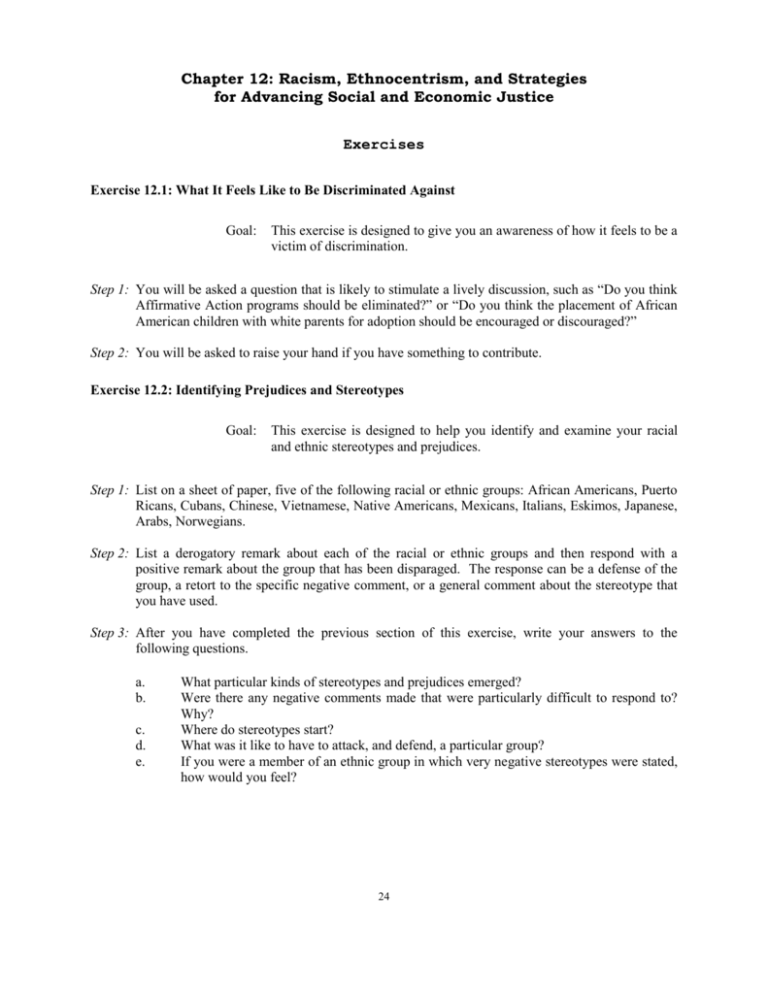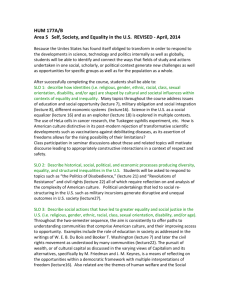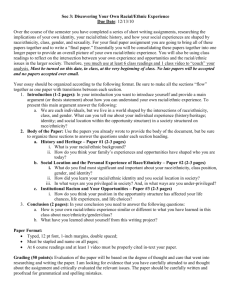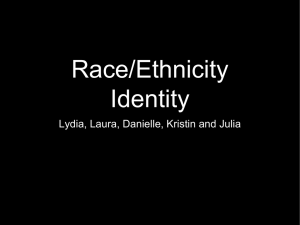Exercises
advertisement

Chapter 12: Racism, Ethnocentrism, and Strategies for Advancing Social and Economic Justice Exercises Exercise 12.1: What It Feels Like to Be Discriminated Against Goal: This exercise is designed to give you an awareness of how it feels to be a victim of discrimination. Step 1: You will be asked a question that is likely to stimulate a lively discussion, such as “Do you think Affirmative Action programs should be eliminated?” or “Do you think the placement of African American children with white parents for adoption should be encouraged or discouraged?” Step 2: You will be asked to raise your hand if you have something to contribute. Exercise 12.2: Identifying Prejudices and Stereotypes Goal: This exercise is designed to help you identify and examine your racial and ethnic stereotypes and prejudices. Step 1: List on a sheet of paper, five of the following racial or ethnic groups: African Americans, Puerto Ricans, Cubans, Chinese, Vietnamese, Native Americans, Mexicans, Italians, Eskimos, Japanese, Arabs, Norwegians. Step 2: List a derogatory remark about each of the racial or ethnic groups and then respond with a positive remark about the group that has been disparaged. The response can be a defense of the group, a retort to the specific negative comment, or a general comment about the stereotype that you have used. Step 3: After you have completed the previous section of this exercise, write your answers to the following questions. a. b. c. d. e. What particular kinds of stereotypes and prejudices emerged? Were there any negative comments made that were particularly difficult to respond to? Why? Where do stereotypes start? What was it like to have to attack, and defend, a particular group? If you were a member of an ethnic group in which very negative stereotypes were stated, how would you feel? 24 Exercise 12.3: Star Track to New Venus Goals: This exercise is designed to help you identify some of your positive and negative stereotypes about various racial and ethnic groups. Step 1: Read the following: You are living in the year 2020. In 2013 the United States discovered a planet in a distant galaxy that appears to have a climate and atmosphere remarkably similar to Earth’s. Scientists are virtually certain that this planet, named New Venus, can support human life. In 2017 the United States began building a new spaceship, named Star Track, that will be capable of transporting 20 people to New Venus. Star Track has recently been completed. In the year 2020 a new comet, Dark Vadim, is discovered and found to be headed on a collision course with Earth. Scientists predict it will strike at the end of that year. A huge explosion, much worse than a nuclear war, is expected, and many scientists are predicting that Earth will disintegrate. The President of the United States has commissioned you to choose the ethnic and racial backgrounds of the 20 people who will soon board Star Track to fly to New Venus in order to continue the human race. The President informs you that you may select the racial and ethnic backgrounds from the following list. Everyone may come from one ethnic or racial background or from a variety of backgrounds. After you provide your selection, the President will select, consistent with your choices, people in their 20s, including ten men and ten women. All the people selected will be fluent in the English language. Step 2: Following is a listing of the possible ethnic and racial groups from which you may choose: Chinese French Filipino Portuguese White American African American Hawaiian Mexican German Vietnamese Hungarian Egyptian Saudi Arabian Israeli Pakistani Nigerian Japanese Polish Irish Italian Iranian Cuban Russian Colombian Nicaraguan Kenyan Haitian Native American Australian Puerto Rican Eskimo Samoan Step 3: Write a list of your choices, and state your reasons for your choices, and why you did not choose people from the racial and ethnic backgrounds that you excluded. Exercise 12:4: Racial and Ethnic Prejudices Goals: This exercise is designed to help you identify your racial and ethnic prejudices and to demonstrate that practically everyone has racial and ethnic stereotypes. Step 1: Read the following: 25 Selecting a Spouse Assume that you are single. Place an X by each of the following groups of which you would be hesitant to marry a member. Your responses will remain anonymous to the class. ____ ____ ____ ____ ____ ____ ____ ____ ____ Russian Cuban French Mexican African American Native American Puerto Rican Italian German ____ ____ ____ ____ ____ ____ ____ ____ ____ Polish Norwegian Samoan Arab Israeli Chinese Japanese Filipino ____ ____ ____ ____ ____ ____ ____ ____ White American ____ Brazilian Hungarian Vietnamese Pakistani Korean Panamanian Nigerian Portuguese Eskimo Step 2: After you have finished this part, write the reasons why you would be hesitant to marry a member of each of the racial and ethnic groups you have checked. In writing your reasons, go beyond general reasons (such as “Parents would disapprove” or “I don’t like members of such groups”) and identify specific reasons why your parents would disapprove or why you dislike members of certain groups. Step 3: Answer the following questions: a. Does this exercise suggest that practically everyone has racial and ethnic stereotypes and prejudices? b. How do such stereotypes and prejudices develop in people? c. How would you feel if you were a member of a racial or ethnic group that was being disparaged by others? d. How can such stereotypes and prejudices be eradicated? Step 4: The instructor will read to the class some of the derogatory statements that are made. 26







